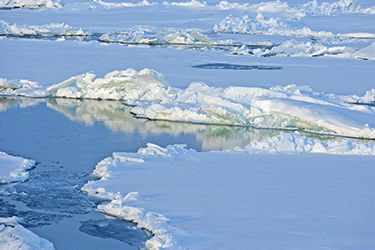In the face of the growing climate crisis, researchers from a variety of fields are focusing their efforts on understanding how different climate systems have altered and will continue to do so as climate change proceeds.

Ice floes in the Arctic. Image Credit: Mike Dunn, NOAA Climate Program Office, NABOS 2006 Expedition
Robert Lund, Professor and Department Chair of Statistics at the UC Santa Cruz Baskin School of Engineering, worked on a recent study that observed declining snow cover in many parts of the northern hemisphere during the last half century using sophisticated mathematical models and statistical methodologies.
Evaluating snow cover patterns is vital because snow plays a significant role in the global energy balance. Snow’s high albedo (ability to reflect light) and insulating properties influence regional surface temperatures and continental thermal stability.
Researchers evaluated snow cover data acquired from weekly satellite flyovers between 1967 (when satellites became more prevalent) and 2021, which was divided into grid sections for analysis in the new study published in the Journal of Hydrometeorology. Scientists determined that snow cover is dropping in nearly twice as many grids as it is progressing in nearly twice as many grids that had valid data.
In the Arctic regions, snow is going away more often than not—I think climatologists sort of suspected this. But it's also going away at the southern boundaries of the continents.
Robert Lund, Professor and Department Chair, Statistics, Baskin School of Engineering, University of California Santa Cruz
The findings reveal that snow presence in the Arctic and southern latitudes of the Northern hemisphere is usually decreasing, while certain locations, like Eastern Canada, are seeing a rise in snow cover. This could be due to rising temperatures in normally cold but still below-freezing places, permitting the atmosphere to store more water, which subsequently falls as snow.
Because of the precision of the researchers’ statistical methodology, Lund believes this is the first fully reliable estimate of snow cover patterns in the Northern Hemisphere. Non-statisticians frequently struggle to derive trends from this type of satellite data, which is displayed as a series of 0s or 1s to indicate whether the snow was present during a certain week.
When looking at trends, the investigators also had to consider correlation, because the existence of snow cover one week strongly influences the likelihood of snow cover the following week. A Markov chain-based model was used to account for these two factors. The model could produce accurate uncertainty estimates for the trends. The researchers discovered hundreds of grids with at least 97.5 % assurance that snow cover was declining.
Researchers did discover, however, that some of the satellite data collected in mountainous places were unreliable, indicating no snow in the winter and several weeks of snow in the winter. This was most likely due to a flaw in the algorithm that evaluated satellite data to identify whether or not snow was present.
The reason this study took a lot of work is because the satellite data is so doggone poor. Whatever the meteorologists did to estimate snow from the pictures in some of the mountainous regions just didn't work, so we had to take all the grids in the Northern Hemisphere, and figure out whether the data was even trustworthy or not.
Robert Lund, Professor and Department Chair, Statistics, Baskin School of Engineering, University of California Santa Cruz
This research, by determining whether satellite data is untrustworthy, can serve as a resource to the scientific community, who may also want to analyze this snow cover data for their research.
Lund partnered on this research with UCSC PhD Candidate Jiajie Kong, Assistant Professor of Math and Statistics at the University of North Florida Yisu Jia, Professor of Meteorology and Climatology at Mississippi State University Jamie Dyer, Associate Professor of Statistics at Mississippi State University Jonathan Woody, and Professor of Statistics and Operations Research at the University of North Carolina at Chapel Hill J. S. Marron.
The study was funded by the National Science Foundation.
Journal Reference
Jia, Y., et al. (2023). Trends in Northern Hemispheric Snow Presence. Journal of Hydrometeorology. doi.org/10.1175/jhm-d-22-0182.1.